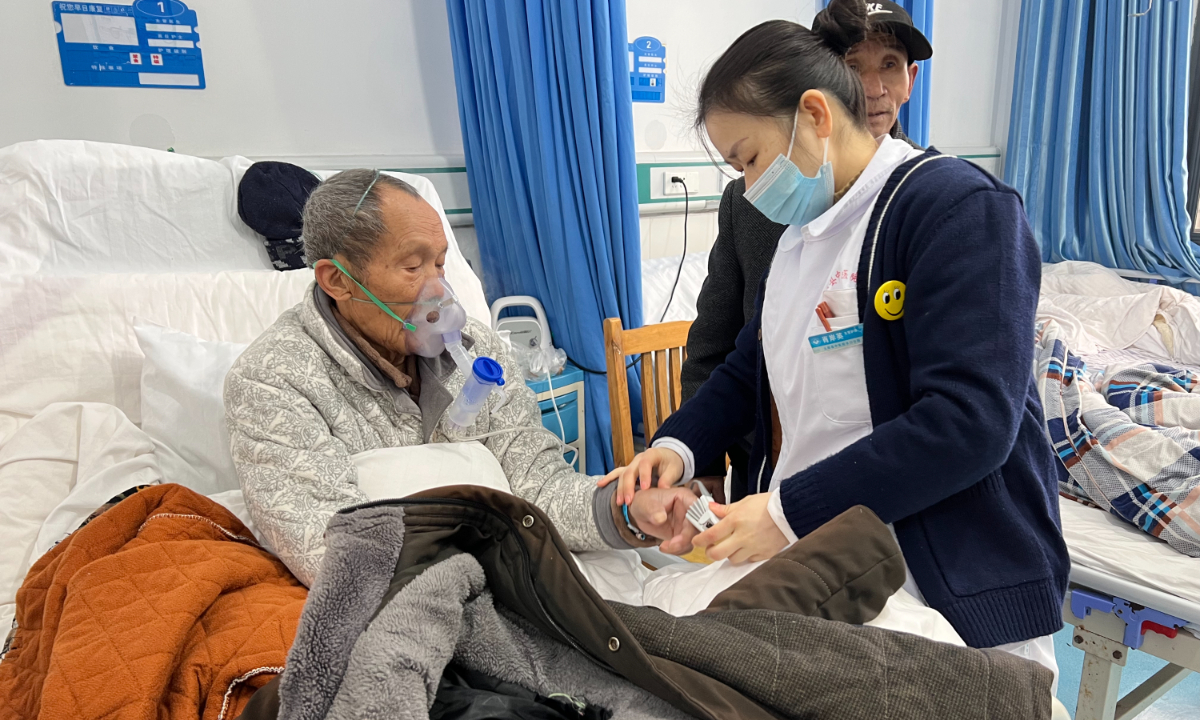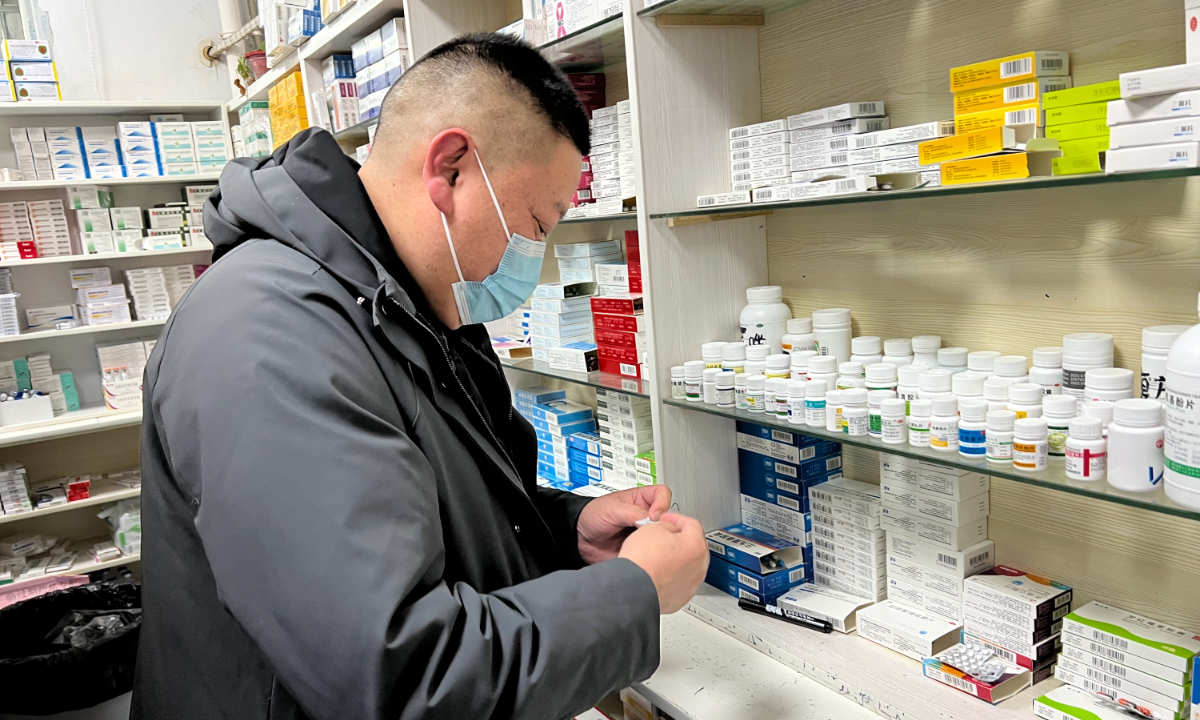
A nurse in Shuikou township hospital in Yunyang county, Chongqing checks the blood oxygen of a COVID-19 patient. Photo: Zhao Yusha/GT
Unlike some Western media reports that predicted China’s rural areas and small cities would see mass infections following the Spring Festival holidays, the Global Times learned from different localities that the numbers of positive cases have been largely declining during the holidays while some third- and fourth-tier cities have already passed peak infections.
A doctor surnamed Wu, who is the owner of a clinic in Hengfeng county, East China’s Jiangxi Province, told the Global Times on Wednesday that there had been no COVID-19 patients seeking treatment in her clinic during the Spring Festival holidays so far as the infection peak in the county had passed a few weeks ago.
Wu received nearly 30 patients during the half-month infection peak from December 19, 2022 to early January. Among them, the majority were aged between 50 and 80, she said, noting that there were five or six COVID patients aged over 80.
Some were coughing, some reporting chest pain, some with bloody sputum, vomiting or body aches, Wu said, noting that antipyretics, antivirals and infusion to reduce inflammation were the common treatment in response to the symptoms.
All the patients she received have recovered and none has been transferred to the county hospital.
Overall visits to fever clinics nationwide reached a peak of 2.87 million on December 23, 2022 and dropped to 63,000 on January 23, according to a latest report from Chinese Center for Disease Control and Prevention (China’s CDC).
Those visits to fever clinics in rural areas reached a peak on December 23, 2022 at 922,000, declining 94.6 percent from their peak to 50,000 on January 23, the report stated.
After the local infection peak, patients with COVID-19 symptoms saw a dramatic decline, Wu said.
Also, during the Spring Festival holidays, common diseases such as cold, fever and bronchitis during the previous Spring Festival holidays also decreased significantly, the doctor noted.
“I have prepared and stored enough medicines and equipment in response to the possible COVID case surge and other common diseases for the Spring Festival, but it turns out that my clinic and other clinics in the county received few patients,” Wu said.
Some public health experts earlier predicted that the Spring Festival travel rush wouldn’t trigger a large-scale epidemic resurgence, as most Chinese megacities have already passed their peak of COVID infections while small-scale outbreaks in some areas, especially in remote rural areas, are likely.

Wang Hailin, head of the Shuikou township hospital in Yunyang county, Chongqing, prepares medicine for patients. Photo: Zhao Yusha/GT
The Global Times visited a hospital in Shuikou township in Yunyang county, Southwest China’s Chongqing on Monday. A total of seven patients with severe COVID-19 symptoms were hospitalized in the hospital, which has 30 beds. So most hospital beds were empty.
Wang Hailin, the hospital head, told the Global Times that COVID-19 infection had already ebbed away in this small town two weeks ago, and fever clinics receive less than 10 people per day. He said the hospital made emergency plan of asking all employees to stand by 7/24 in case the caseload surges during Spring Festival. “But there’s no such huge outbreak currently and things are so much better than we previously estimated.”
The hospital also has abundant inventory of medicines, including ibuprofen and China’s domestically developed antiviral Azvudine.
The effect of Spring Festival travel rush on the small town’s COVID-19 infection will only emerge two weeks later, said Wang.
He also showed the Global Times a CT scan room which is connected with county-level hospitals. The CT scan result will be simultaneously viewed by experts in theYunyang county hospital, which is with better equipment and resources. Once the patient is diagnosed as with severe symptoms, he (or she) will be transferred to the Yunyang county hospital within 20 minutes, said Wang.
The Global Times reporter also visited a health center of Caoji Village under the renowned tourist attraction Pingyao ancient city in North China's Shanxi Province on Wednesday. The doctor at the facility said that the village had passed the peak of COVID-19 infection a month ago, and no new clusters of infections had occurred during the Spring Festival holidays.
“Some villagers showing COVID-19 symptoms were treated here like colds with traditional Chinese medicine and recovered quickly. Some severe patients who had been treated in city hospitals came here for a re-check and they had been much better. Before Spring Festival, medical supplies received from the local government have been distributed to villagers,” the doctor surnamed Xu told the Global Times.
The Global Times reporter visited several families in the village and learned that they received medicines treating fever and cough. They said they did not know whether they had COVID-19 or cold because they didn't have a test, but they believed they were recovered from COVID-19 and are ready to embrace a new life, a life they could earn money through hardworking and reunite with their children during holidays.
In a local hospital in Yichang, Central China’s Hubei Province, the number of patients visiting the fever clinic has been falling over recent days. The Global Times learned from the hospital that the peak of COVID infections had passed, with the patients dropping from about 585 who had fever in mid-December to now only several patients.
“During the peak period, we received about 400 patients every day,” a local doctor surnamed Chen told the Global Times. Now the pressure on the fever clinics has been eased and we have prepared for the possible resurgence during the Spring Festival holidays with more medical staff and medicines.
“There are much fewer patients now than we expected. I think one reason is that those with mild symptoms choose to stay at home for recovering instead of going to the hospital,” the doctor said.
Also, the clinics in the villages have been preparing for a possible resurgence during the holidays, which planned to transfer their patients to our hospital, Chen noted.
“We scheduled sufficient medical staff for receiving those patients from the villages, but the situation now is much better than we thought,” the doctor said.
China has been stressing the anti-epidemic work in rural areas before the Spring Festival holidays started. Some preparation work includes a nationwide survey covering 590 million people in rural areas particularly for some key groups such as the elderly, children and people with underlying diseases, and offering over 57 million healthcare packages.
In Dongxiang, a district located in Fuzhou of Jiangxi Province, local authorities apologized on Tuesday night for organizing nucleic acid testing, which sparked online controversy as the nucleic acid testing is no longer needed after China optimized its COVID response in early December 2022. It said the service was only for those who need to take the test.
The district has already passed the peak of infections steadily amid the current wave and will follow the country’s instructions in anti-epidemic work, according to local authorities.





